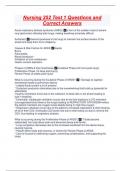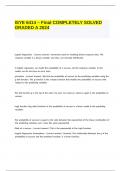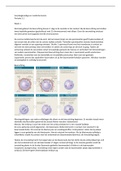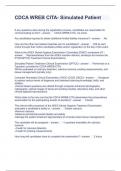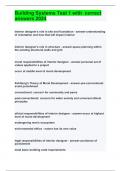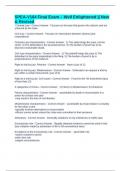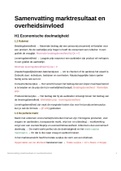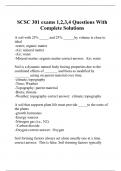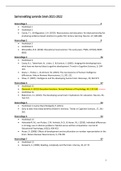Correct Answers
Acute respiratory distress syndrome (ARDS) ✅a form of the sudden onset of severe
lung dysfunction affecting both lungs, making breathing extremely difficult
Surfactant ✅chemical produced in the lungs to maintain the surface tension of the
alveoli and keep them from collapsing
Causes & Risk Factors for ARDS ✅Sepsis
Burns
Pancreatitis
Blood transfusion
Inhalation of toxic substances
Gastric content aspiration
Phases of ARDS & their timeframes ✅Exudative Phase (24 hours post injury)
Proliferative Phase (14 days post injury)
Fibrotic Phase (3 weeks post injury)
What is occurring during the Exudative Phase of ARDS? ✅* Damage to capillary
membranes leads to pulmonary edema.
* Leaked fluids contain a lot of proteins
* Surfactant production diminishes due to the overwhelming fluid build up (potential for
atelectasis)
*Hyaline membrane forms due to the collection of dead cells in the alveoli leading to
loss in elasticity.
* Eventually, inadequate ventilation occurs due to the fluid leading to a V/Q mismatch
(unoxygenated blood flows to the lungs) leading to REFRACTORY HYPOXEMIA where
the patient maintains low oxygen levels despite being on high flow oxygen.
* Respiratory alkalosis occurs due to the patient's increased respirations & them blowing
off all of their CO2. Eventually CO2 levels rise due to there being no way to remove the
CO2, thus leading to respiratory acidosis.
What is occurring during the Proliferative Phase of ARDS? ✅* Fluids become
reabsorbed, but lung tissue scars and becomes dense and fibrotic.
* Lung compliance decreases due to the increased workload from the dense tissue,
causing hypoxia.
* Patient either heals and recovers, or enters the Fibrotic Phase of ARDS.
* Care is focused on delivering oxygen, preventing complications, and supporting the
lungs.
,What is occurring during the Fibrotic Phase of ARDS? ✅Patients who enter this phase
have poorer outcomes and major lung damage.
What are three common types of Mechanical Ventilation? ✅Assist-Control Ventilation
(AC)
Synchronized Intermittent Mandatory Ventilation (SIMV)
Bi-Level Positive Airway Pressure (bipap)
Explain Assist-Control Ventilation ✅* Takes over work of breathing for patient
* Tidal volume and rate are preset
* If patient does not spontaneously breath, the ventilator establishes a pattern for them.
* If a patient takes a spontaneous breath, the machine will still deliver the preset tidal
volume, which can cause hyperventilation and respiratory alkalosis.
Explain Synchronized Intermittent Mandatory Ventilation ✅* Similar to AC in that tidal
volume and rate are preset
* Allows spontaneous breathing at a patient's own rate and tidal volume between
ventilated breaths
* Can be used as a main vent mode or as a weening mode
Explain Bi-Level Positive Airway Pressure ✅* Noninvasive pressure support ventilation
by nasal mask or facemask
* Most often used for sleep apnea
* May be used for patients with respiratory muscle fatigue or impending respiratory
failure
What is tidal volume and what is it's normal ventilator setting? ✅* The volume of air a
patient receives with each breath
* 6-8 ml/kg
On a ventilator, what is rate and what is it's normal setting? ✅* The number of breaths
per minute delivered
* 10-14 breaths per minute
On a ventilator, what is fio2 and what is it's normal setting? ✅* Fraction of Inspired O2.
Value is prescribed based on the patient's abgs.
* 21% - 100%
*** Oxygen must be warmed and humidified to prevent mucosal damage!
On a ventilator, what is PIP and what is its normal setting? ✅* Peak Airway Inspired
Pressure. The pressure used by the ventilator to deliver a set tidal volume; the highest
pressure reached during inspiration.
* Average setting is patient dependent. An increase may mean airway resistance such
as bronchospasm, pinched tubing, increased secretions, pulmonary edema, or
decreased pulmonary compliance.
, What is Continuous Positive Airway Pressure (CPAP) & what is its normal setting? ✅*
Application of positive airway pressure throughout entire respiratory cycle for
spontaneous breaths. Keeps alveoli open during inspiration and prevents alveolar
collapse during expiration.
* Normal levels are 5-15 cm/H2O
What is Positive End Expiratory Pressure (PEEP) and what is its normal setting? ✅*
Pressure exerted during expiration to improve oxygenation and prevent atelectasis.
* Added when pao2 is low with fio2 >50%.
* Average PEEP is 5-15 cm/H2O
On a ventilator, what is Flow Rate and what is its normal setting? ✅* How fast each
breath is delivered
* Average Flow Rate is 40 L/min
On a ventilator, what is a high pressure alarm and what are some causes? ✅* Sounds
when peak inspiratory pressure reaches the set alarm limit.
* Increased amount of secretions or mucus plug in the airway
* The patient coughs, gags, or bites the ETT
* Patient is anxious or fighting the ventilator
* Airway size decreases related to bronchospasm
* Pneumothorax occurs
* ETT displacement
* Decreased lung compliance
On a ventilator, what is a Low-Pressure alarm & what are some causes? ✅* Sounds
when there is a disconnection or leak in the ventilator circuit or a leak in the ETT cuff.
* Leak in the ventilator circuit prevents breath from being delivered
* Patient stops spontaneously breathing when in SIMV or CPAP mode.
* ETT cuff leak
***Always assess patient before machine
What are some complications associated with ventilator use? ✅* Cardiac -
hypotension and fluid retention
* Barotrauma (damage to lung by positive pressure) - pneumothorax, subcutaneous
emphysema, pneumomediastinum.
* Volutrauma - damage to lung by excessive volume delivered to a lung
* Atelectrauma - injury to alveoli from opening and closing
* Biotrauma - inflammatory response damage to alveoli
* Ventilator associated lung injury - damage to lungs from prolonged ventilation
* Ventilator associated pneumonia
What are some steps to prevent ventilator associated pneumonia? ✅* Keep head of
bed elevated to at least 30 degrees

